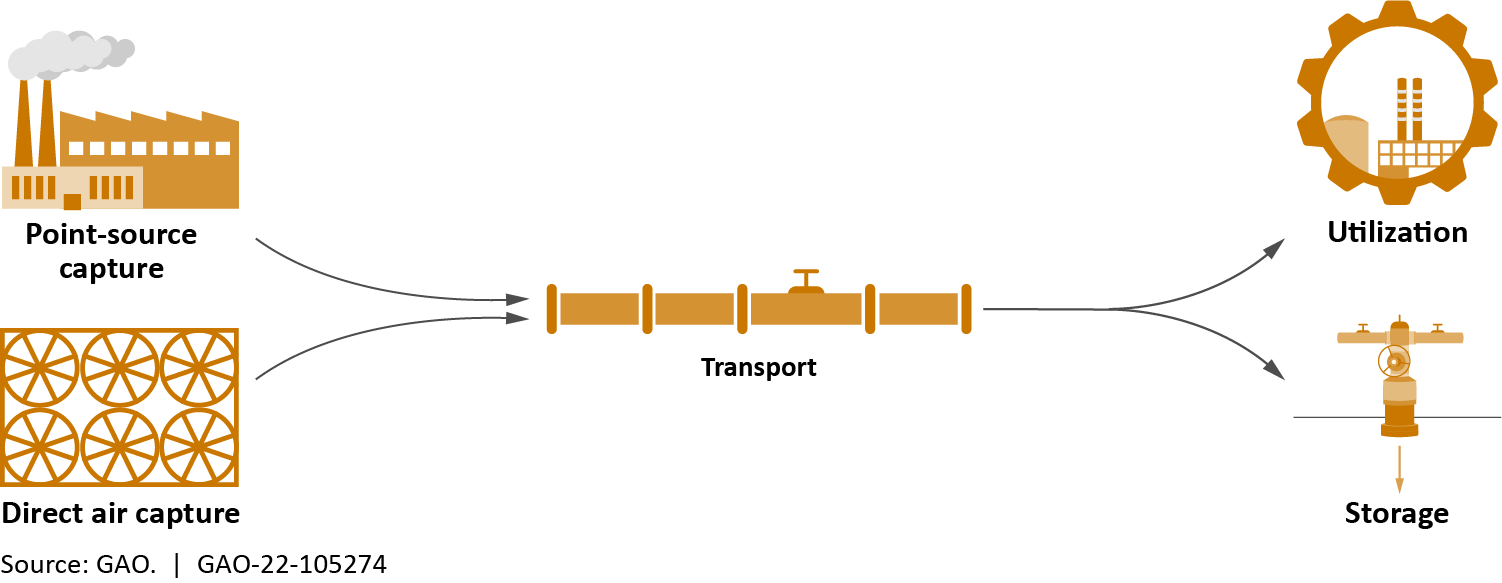Decarbonization: Status, Challenges, and Policy Options for Carbon Capture, Utilization, and Storage
Fast Facts
Technologies that capture, use, and store carbon can help address climate change. These technologies capture CO2 at sources like industrial facilities or remove it from the atmosphere, then either store it underground or use it to produce goods, like concrete.
Many of these technologies are ready for wider demonstration or deployment. But, the industry overall is in its infancy and faces multiple challenges, including high costs.
We offer seven policy options to help address such challenges. For example, further demonstration of these technologies in real-world conditions could reduce costs, although such projects require careful oversight.

Highlights
What GAO Found
Many technologies for carbon capture, utilization, and storage (CCUS) are ready for wider demonstration or deployment, but multiple challenges limit their use. Carbon capture includes technologies that separate and purify carbon dioxide (CO2) from a source, which could be an industrial facility (point-source capture) or the atmosphere (direct air capture). Applications of capture technologies at point sources are mature in some sectors (e.g., natural gas processing) but require further demonstration in some of the highest-emitting sectors (e.g., power generation). Direct air capture is not as mature, but has been implemented at pilot scale. Lengthy time to deployment and high costs hinder widespread deployment of both types of carbon capture in the near term.
Technologies for transporting, storing, and directly using captured CO2 are mature. Companies are beginning to commercialize utilization technologies that convert captured CO2 into valuable products such as ethanol, sustainable aviation fuel, and mineral aggregates. However, many CO2-based products are not competitive with conventional products, may be excluded from the market by industry standards, and lack a standardized method for ensuring they effectively reduce CO2 emissions.
Components of carbon capture, utilization, and storage

GAO identified three aspects of CCUS deployment where challenges may arise:
- Cost. Deploying CCUS is an added cost to doing business but currently offers few opportunities to generate revenue. Incentives such as federal tax credits help offset the high cost of CCUS for some but not all emitters.
- Infrastructure development. More widespread deployment of CCUS would require a build-out of infrastructure for each of its components, including transport and storage. Timing of development, negotiating land access, and proximity of facilities are all challenges affecting this build-out.
- Community engagement. Deploying CCUS projects relies on acceptance by and effective engagement with local communities. In the past, unsuccessful community engagement and local opposition have contributed to cancellation or relocation of some CCUS projects, while others were well received.
GAO identified seven policy options that could help address these challenges or enhance the benefits of CCUS technologies. The policy options are possible actions by policymakers, which may include Congress, federal agencies, state and local governments, academic and research institutions, and industry. In addition, policymakers could choose to maintain the status quo, whereby they would not take additional action beyond current efforts. See below for details of the policy options and selected opportunities and considerations.
Policy options to help address challenges or enhance benefits of CCUS technologies, with selected opportunities and considerations
| Policy Option | Opportunities | Considerations |
|
Research, development, and demonstration (report p. 20)
Policymakers could enhance support for consistent funding of research and development and large-scale demonstrations simultaneously. |
|
|
|
Technology-neutral standards (report p. 34)
Policymakers could encourage the creation, adoption, or use of technology-neutral standards. |
|
|
|
Standardized life cycle assessment guidelines (report p. 34)
Policymakers could support the creation and use of standardized life cycle assessment guidelines to validate CO2 benefits of CO2-based products. |
|
|
|
Framework for land access (report p. 44)
|
|
|
|
Strategic siting (report p. 44)
|
|
|
|
Modify incentives (report p. 55)
Policymakers could modify existing incentives to facilitate access for CCUS projects. |
|
|
|
Community engagement (report p. 62)
Policymakers could support and encourage proactive community engagement around CCUS deployment. |
|
|
Source: GAO. | GAO-22-105274
Why GAO Did This Study
In 2021, CO2 reached a record high concentration in the Earth's atmosphere for the modern era. Scientific assessments have shown that reducing CO2 emissions could help mitigate the negative effects of climate change. CCUS is one tool available to help slow, stop, or potentially reverse the rising levels of CO2 in the atmosphere.
This report discusses (1) the status of available carbon capture technologies; (2) opportunities for using or storing captured CO2; (3) key challenges that could affect the development, demonstration, and deployment of CCUS technologies; and (4) options policymakers could consider to help address these challenges.
In conducting this assessment, GAO interviewed federal officials, academic researchers, industry organizations, private companies, nongovernmental organizations, technology testing centers, and federal advisory committees; In conducting this assessment, GAO interviewed federal officials, academic researchers, industry organizations, private companies, nongovernmental organizations, technology testing centers, and federal advisory committees; convened an interdisciplinary meeting of 27 experts with assistance from the National Academies of Sciences, Engineering, and Medicine; and reviewed relevant literature. GAO is identifying policy options in this report.
For more information, contact Karen L. Howard at (202) 512-6888 or howardk@gao.gov.
